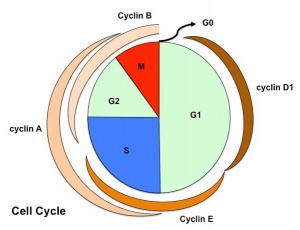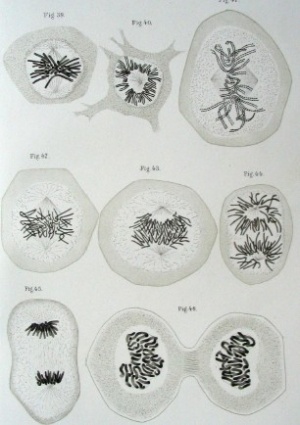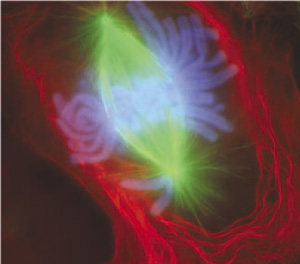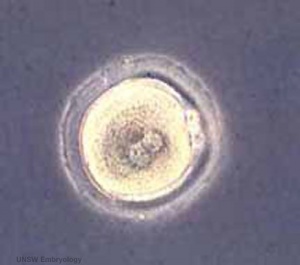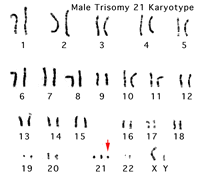2009 Lecture 2
Cell Division and Fertilization
This lecture will introduce two key concepts of biology, cell division and cellular sexual development. Both these concepts will also be explored further in the Thursday laboratory.
--MarkHill 15:44, 27 July 2009 (EST) Lecture notes in preparation (notice removed when complete)
Cell Cycle
- Cell Division (m phase) is only a brief moment in the functional life (interphase) of most eukaryotic cells.
- The eukaryotic cell cycle is regulated by 2 protein families known as cyclins and cyclin-dependent kinases.
Cell Division
- Cell Division Milestones, Recent Nobel Prizes
Features 2 mechanical processes
- Mitosis segregation of chromosomes and formation of 2 nuclei
- Cytokinesis splitting of the cell as a whole into 2 daughter cells
- Mitosis occurs in all cells, producing genetically identical progeny.
- Meiosis occurs only in germ cells (sperm=spermatozoa and egg=oocyte), producing genetically different progeny.
- progeny = daughter cells, offspring
Cell Changes
- Nucleus
- Chromosome condensation
- Nuclear envelope breakdown
- Cytoplasm
- Cytoskeleton reorganization
- Spindle formation (MT) Contractile ring (MF)
- Organelle redistribution
Mitosis
- Based on light microscopy of living cells light and electron microscopy of fixed and stained cells
- 5 Phases - prophase, prometaphase, metaphase, anaphase, and telophase
- Cytokinesis 6th stage overlaps the end of mitosis
Note that DNA duplication has occurred earlier in the S Phase of the cell cycle.
Prophase
- Chromosome DNA has been earlier duplicated (S Phase)
- Chromosomes begin condensing
- Chromosome pairs (chromatids) held together at centromere
- Microtubules disassemble
- Mitotic spindle begins to form
- Prophase ends when nuclear envelope breaks down
Prometaphase
- Microtubules now enter nuclear region
- Nuclear envelope forms vesicles around mitotic spindle
- Kinetochores form on centromere attach to some MTs of spindle
- Prometaphase ends when chromosomes move to metaphase plate
Metaphase
- Kinetochore MTs align chromosomes in one midpoint plane
- Metaphase ends when sister kinetochores separate
Anaphase
- Separation of sister Kinetochores
- shortening of Kinetochore microtubules pulls chromosome to spindle pole
- Anaphase ends as nuclear envelope (membrane) begins to reform
Telophase
- Chromosomes arrive at spindle poles
- Kinetochore MTs lost
- Condensed chromosomes begin expanding
- Continues through cytokinesis
Cytokinesis
- Division of cytoplasmic contents
- Contractile ring forms at midpoint under membrane
- Microfilament ring Contracts forming cleavage furrow
- Eventually fully divides cytoplasm
Cell Organelles
- Mitochondria - Divide independently of cell mitosis, distributed into daughter cells
- Peroxisomes - localise at spindle poles
- Endoplasmic Reticulum - associated with the nuclear envelope vesicles.
- Golgi Apparatus- Golgi stack undergoes a continuous fragmentation process, fragments are distributed into daughter cells, then reassembled into new Golgi stacks
Meiosis
Meiosis Germ cell division (haploid)
- Reductive division
- Generates haploid gametes (egg, sperm)
- Each genetically distinct from parent
- Genetic recombination (prophase 1)
- Exchanges portions of chromosomes maternal/paternal homologous pairs
- Independent assortment of paternal chromosomes (meiosis 1)
Homologous chromosomes pairing unique to meiosis
- Each chromosome duplicated and exists as attached sister chromatids before pairing occurs
- Genetic Recombination shown by chromosomes part red and part black
- chromosome pairing in meiosis involves crossing-over between homologous chromosomes
Meiosis I and II
- Meiosis I separates the pairs of homologous chromosomes, reduces the cell from diploid to haploid.
- Meiosis II separates each chromosome into two chromatids (chromosome behavior in meiosis II is like that of mitosis).
Figure 14.32. Comparison of meiosis and mitosis
Prophase I
- The homologous chromosomes pair and exchange DNA to form recombinant chromosomes.
- Prophase I is divided into five phases:
- Leptotene - chromosomes start to condense.
- Zygotene - homologous chromosomes become closely associated (synapsis) to form pairs of chromosomes consisting of four chromatids (tetrads).
- Pachytene - crossing over between pairs of homologous chromosomes to form chiasmata (form between two nonsister chromatids at points where they have crossed over)
- Diplotene - homologous chromosomes begin to separate but remain attached by chiasmata.
- Diakinesis - homologous chromosomes continue to separate, and chiasmata move to the ends of the chromosomes.
Prometaphase I
- Spindle apparatus formed, and chromosomes attached to spindle fibres by kinetochores.
Metaphase I
- Homologous pairs of chromosomes (bivalents) arranged as a double row along the metaphase plate. The arrangement of the paired chromosomes with respect to the poles of the spindle apparatus is random along the metaphase plate. (This is a source of genetic variation through random assortment, as the paternal and maternal chromosomes in a homologous pair are similar but not identical. The number of possible arrangements is 2n, where n is the number of chromosomes in a haploid set. Human beings have 23 different chromosomes, so the number of possible combinations is 223, which is over 8 million.)
Anaphase I
The homologous chromosomes in each bivalent are separated and move to the opposite poles of the cell.
Telophase I
The chromosomes become diffuse and the nuclear membrane reforms.
Cytokinesis I
- Cellular cytoplasmic division to form two new cells, followed by Meiosis II.
Prophase II
- Chromosomes begin to condense, nuclear membrane breaks down and spindle forms.
Metaphase II
- Spindle fibres attach to chromosomes, chromosomes align in cell centre.
Anaphase II
- Chromosomes separate and move to the opposite poles of the cell.
Telophase II
- Chromosomes reach spindle pole ends and the nuclear membrane reforms.
Cytokinesis
Cellular cytoplasmic division to form new cells.
Comparison of Meiosis/Mitosis
McGraw-Hill Animation comparing Mitosis and Meiosis
- After DNA replication 2 nuclear (and cell) divisions required to produce haploid gametes
- Each diploid cell in meiosis produces 4 haploid cells (sperm) 1 haploid cell (egg)
- Each diploid cell mitosis produces 2 diploid cells
Meiosis Differences
Female - Oogenesis
Figure 14.37. Meiosis of vertebrate oocytes
- Meiosis initiated once in a finite population of cells
- 1 gamete produced / meiosis
- Completion of meiosis delayed for months or years
- Meiosis arrested at 1st meiotic prophase and reinitiated in a smaller population of cells
- Differentiation of gamete occurs while diploid in first meiotic prophase
- All chromosomes exhibit equivalent transcription and recombination during meiotic prophase
Male - Spermatogenesis
- Meiosis initiated continuously in a mitotically dividing stem cell population
- 4 gametes produced / meiosis
- Meiosis completed in days or weeks
- Meiosis and differentiation proceed continuously without cell cycle arrest
- Differentiation of gamete occurs while haploid after meiosis ends
- Sex chromosomes excluded from recombination and transcription during first meiotic prophase
Polar Bodies
- In female gametogenesis only a single (1) haploid egg is produced from meiosis. In male gametogenesis four (4) haploid sperm are produced from meiosis. So what happens to all the extra DNA in producing this single egg?
- In Meiosis 1 the "extra" DNA is excluded to the periphery as a 1st polar body, which encloses the extra DNA.
- In Meiosis 2 the "extra" DNA is once again excluded as a 2nd polar body. The first polar body may also under go meiosis 2 producing a 3rd polar body.
- These polar bodies are not gametes.
- Polar bodies appear to have no other function other than to dispose of the extra DNA in oogenesis.
- Recent research in mice suggest that the position of oocyte polar body may influence fertilization site.
Abnormalities
- The most common chromosome abnormality is aneuploidy, the gain or loss of whole chromosomes.
- Caused by meiotic nondisjunction, the failure of chromosomes to correctly separate homologues during meiosis I or sister chromatids during meiosis II.
- Down Syndrome - caused by an extra copy of chromosome 21. Abnormal Development - Trisomy 21 (Down Syndrome)
- Chromosomal translocations occur when there is an inappropriate exchange of chromosomal material. Philadelphia chromosome
- Philadelphia chromosome - piece of Chr9 exchanged with Chr22 Generates truncated abl, overstimulates cell production, leads to chronic myelogenous leukemia
Fertilization
- Fertilization is the complete process resulting in the fusion of haploid gametes, egg and sperm, to form the diploid zygote.
- The recent development of aided fertilization is described as in vitro fertilization (in vitro = "in glass", outside the body, IVF).
- Clinically, all these aided fertilization techniques are grouped as Assisted Reproductive Technologies or ART.
- sperm moving between granulosa cells to contact the zona pellucida.
- sperm releasing acrosomal contents to breakdown zona pellucida.
- sperm fusing with egg membrane.
- egg releasing cortical granule contents.
- egg completing meiosis.
- Fertilization and Early Development
- Gamete formation
- egg formation-oogenesis
- sperm formation- spermatogenesis
- Fertilization
- sperm and egg migration
- sperm- activation, binding, acrosome reaction
- egg- 2nd meiotic division, cortical reaction
- Formation of the Zygote
- male and female pronuclei
- first mitotic division
- sex determination
- Formation of the Blastocyst
- Female Reproductive
- Early cell division
- Gamete formation
- Gamete formation- Oogenesis
- process of oogonia mature into oocytes (ova, ovum, egg)
- all oogonia form primary oocytes before birth
- maturation of preexisting cells in the female gonad- ovary
- humans usually only 1 ovum released (IVF- superovulation)
- oocyte and its surrounding cells = follicle
- primary -> secondary -> ovulation releases
- Ovary- Histology - whole transverse section (cortex, medulla)
- Menstrual Cycle
- Oogenesis- preantral follicle
- Primary Oocyte
- arrested at early Meiosis 1
- diploid: 22 chromosome pairs + 1 pair X chromosomes (46, XX)
- autosomes and sex chromosome
- Oogenesis- antral follicle
- Secondary oocyte
- 1 Day before ovulation completes (stim by LH) Meiosis 1
- haploid: 22 chromosomes + 1 X chromosome (23, X)
- nondisjunction- abnormal chromosome segregation
- begins Meiosis 2 and arrests at metaphase
- note no interphase replication of DNA
- only fertilization will complete Meiosis 2
- 2nd Meiotic Division
- Ovulation
- Hypothalmus (GRH) -> Pituitary FSH and LH -> ovary
- GRH- gonadotropin releasing hormone
- FSH- follicle stimulating hormone
- LH- lutenizing hormone
- release of the secondary oocyte and formation of corpus luteum
- secondary oocyte encased in zona pellucida and corona radiata
- Ovulation- ampulla movement
- Ovulation- follicle
- Zona Pellucida
- glycoprotein shell ZP1, ZP2, ZP3
- mechanical protection of egg
- involved in the fertilization process
- sperm binding
- adhesion of sperm to egg
- acrosome reaction
- releases enzymes to locally breakdown
- block of polyspermy
- altered to prevent more than 1 sperm penetrating
- may also have a role in development of the blastocyst
- Corona Radiata
- granulosa cells and extracellular matrix
- protective cells for egg durin transport
- cells are also lost duringtransport along oviduct
- nutrition
- Testis- anatomy and histology
- Gamete formation- Spermatogenesis
- process of spermatagonia mature into spermatazoa (sperm)
- continuously throughout life occurs in the seminiferous tubules in the male gonad- testis (plural testes)
- at puberty spermatagonia activate and proliferate (mitosis)
- primary spermatocyte -> secondary spermatocyte-> spermatid->sperm
- Maturation involves meiosis and spermeogenesis
- Seminiferous Tubule
- Spermatogenesis- Meiosis
- meiosis is reductive cell division
- 1 spermatagonia (diploid) = 4 sperm (haploid)
- 46, XY (also written 44+XY)
- 23, X
- 23, X
- 23, Y
- 23, Y
- Spermiogenesis - morphological (shape) change
- Spermatogenesis- spermeogenesis
- cell shape change round spermatids -> elongated sperm
- loose cytoplasm
- Transform golgi apparatus into acrosome (in head)
- Organize microtubules for motility (in tail, flagellum)
- Segregate mitochondria for energy (in tail
- Ejaculate
- 3.5 ml, 200-600 million sperm
- Infertility - Oligospermia, Azoospermia, Immotile Cilia Syndrome
- Oligospermia (Low Sperm Count)
- less than 20 million sperm after 72 hour abstinence from sex
- Azoospermia (Absent Sperm)
- blockage of duct network
- Immotile Cilia Syndrome
- lack of sperm motility
- By volume <10 % sperm
- Accessory Glands
- 60 % seminal vesicle
- 10 % bulbourethral
- 30 % prostate
- Fertilization-sperm and egg migration
- Sperm migration
- deposited in vagina
- have approximately 24-48h to fertilize
- migrate through cervix into uterus
- from uterus into oviduct (= uterine horn, fallopian tube)
- Egg migration
- following ovulation from ovary into fimbria
- then into oviduct
- Fertilization Site
- Fertilization usually occurs in first 1/3 of oviduct
- Fertilization can occur outside oviduct
- associated with ectopic pregnancy
- In virto Fertilization- IVF, GIFT, ZIFT....
- the majority of fertilized eggs do not go on to form an embryo
- Fertilization- Sperm
- capacitation
- removal of glycoprotein coat and seminal proteins
- alteration of sperm mitochondria
- binding
- ZP3 acts as receptor for sperm
- acrosome reaction
- exyocytosis of acrosome contents (Ca mediated)
- enzymes to digest the zona pellucida
- exposes sperm surface proteins to bind ZP2
- membrane fusion
- between sperm and egg
- allows sperm nuclei passage into egg cytoplasm
- capacitation
- Fertilization- Egg
- sperm membrane fusion
- causes depolarization of egg membrane
- primary block to polyspermy
- Egg Cortical Reaction
- IP3 pathway elevates intracellular Calcium
- exocytosis of cortical granules
- enzyme alters ZP3 so it will no longer bind sperm plasma membrane
- 2nd meiotic division
- completion of 2nd meiotic division
- forms second polar body (a third polar body may be formed by meiotic division of the first polar body)
- Formation of the Zygote
- Male and Female Pronuclei
- 2 haploid nuclei approach each other
- nuclear membranes break down
- chromosomal pairing
- DNA replicates
- first mitotic division
- Sperm contributes - centriole which organizes mitotic spindle
- Oocyte contributes - mitochondria (maternally inherited)
- Sex Determination
- based upon whether an X or Y carrying sperm has fertilized the egg
- should be 1.0 sex ratio
- is actually 1.05, 105 males for every 100 females.
- some studies show more males 2+ days after ovulation
- cell totipotent (equivalent to a stem cell, can form any tissue of the body)
- Men- Y Chromosome
- carries sry gene
- gene activates pathway for male gonad (covered in genital development)
- Women- X Chromosome
- one X chromosome in each woman's cell has to be inactivated (because men only have 1 X chromosome, if abnormal, this leads to X-linked diseases more common in male that female where bothe X's need to be abnormal)
- process is apparently random
- therefore 50% of cells have father's X, 50% have mother's
- one X chromosome in each woman's cell has to be inactivated (because men only have 1 X chromosome, if abnormal, this leads to X-linked diseases more common in male that female where bothe X's need to be abnormal)
UNSW Embryology Links
- Lecture 2 2008
- Week 1 - Spermatogenesis
- Week 1 - Oogenesis
- Week 1 - Fertilization | In Vivo Fertilization | In Vitro Fertilization
- Abnormal Development - Trisomy 21 (Down Syndrome)
- ANAT3231 Cell Division
References
Online Textbooks
- Developmental Biology by Gilbert, Scott F. Sunderland (MA): Sinauer Associates, Inc.; c2000Figure 2.9. Summary of meiosis | fusion of egg and sperm plasma membranes
- Molecular Biology of the Cell 4th ed. Alberts, Bruce; Johnson, Alexander; Lewis, Julian; Raff, Martin; Roberts, Keith; Walter, Peter New York and London: Garland Science; c2002 - IV. Internal Organization of the Cell Chapter 17. The Cell Cycle and Programmed Cell Death Programmed Cell Death | An Overview of the Cell Cycle | Figure 17-1. The cell cycle | Fertilization
- Molecular Cell Biology by Lodish, Harvey; Berk, Arnold; Zipursky, S. Lawrence; Matsudaira, Paul; Baltimore, David; Darnell, James E. New York: W. H. Freeman & Co.; c1999 Chapter 13. Regulation of the Eukaryotic Cell Cycle Regulation of the Eukaryotic Cell Cycle | Overview of the Cell Cycle and Its Control | Figure 13-2. Current model for regulation of the eukaryotic cell cycle
- The Cell - A Molecular Approach by Cooper, Geoffrey M. Sunderland (MA): Sinauer Associates, Inc.; c2000- IV. Cell Regulation Chapter 14. The Cell Cycle The Eukaryotic Cell Cycle | Figure 14.1. Phases of the cell cycle | Figure 14.32. Comparison of meiosis and mitosis | Figure 14.37. Meiosis of vertebrate oocytes
- HSTAT - In Vitro Fertilization As A Medical Treatment For Male or Female Infertility
Search
- Bookshelf cell division | mitosis | meiosis | fertilization
- Pubmed cell division | mitosis | meiosis | fertilization
Reviews
- Cell cycle studies based upon quantitative image analysis. Stacey DW, Hitomi M. Cytometry A. 2008 Apr;73(4):270-8. Review. PMID: 18163464
- Analysis of cell cycle phases and progression in cultured mammalian cells. Schorl C, Sedivy JM. Methods. 2007 Feb;41(2):143-50. Review. PMID: 17189856
Articles
External Links
- JCB - Movie Collection Mitosis | Cytokinesis
- 2008 ANAT3231 Lecture PDF lecture14-15 1 slide/page (view) | 4 slides/page (print) | 6 slides/page (print) | text (print)
- McGraw-Hill Animation comparing Mitosis and Meiosis
- Salmon Lab Mitosis Movies
Next Lecture
Lecture 3 | Lab 1 | Course Timetable
- Dr Mark Hill 2009 UNSW CRICOS Provider Code No. 00098G
